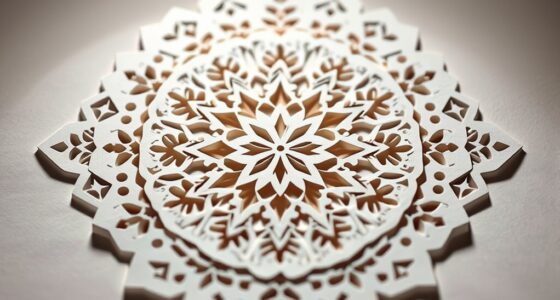To create tessellations in Adobe Illustrator, start by selecting simple shapes like squares, triangles, or hexagons, and customize them with your motifs. Use the Rotate, Reflect, and Translate tools to manipulate your shapes, creating symmetry and seamless repetition. Align your tiles carefully using guides and snapping to avoid gaps or overlaps. With practice, you can combine multiple transformations and patterns, revealing endless design possibilities—continuing below will help you master each step for perfect tessellations.
Key Takeaways
- Begin with simple polygons like squares, triangles, or hexagons to create foundational tessellations.
- Use Adobe Illustrator’s shape tools and guides to design and customize motifs easily.
- Apply symmetry, reflection, and translation tools to manipulate shapes for seamless pattern repetition.
- Arrange shapes precisely, ensuring edges align perfectly for continuous, gap-free patterns.
- Experiment with various transformations and combine symmetry types to develop complex, captivating tessellations.

Have you ever wanted to create seamless, repeating patterns that fit together perfectly? If so, mastering tessellations in Adobe Illustrator is an excellent skill to develop. Tessellations are designs where shapes fit together without gaps or overlaps, creating visually engaging patterns. To do this effectively, understanding the principles of patterns and symmetry is essential. These principles help you design tiles that can be repeated endlessly, maintaining a consistent flow across your artwork. Using geometric transformations, you can manipulate shapes in ways that produce harmonious repetitions, making the process more intuitive and precise. Recognizing how contrast ratio influences the perception of your patterns can also help in designing more striking visuals.
Begin by choosing a shape or motif that will serve as the foundation of your tessellation. Simple polygons like hexagons, squares, or triangles are great starting points because they naturally tessellate. Once you have your shape, use Adobe Illustrator’s shape tools to create or customize your motif. To guarantee seamless repetition, you need to understand how patterns can be built through symmetry. Symmetry can be reflected, rotated, or translated across your design, allowing you to generate complex, eye-catching patterns from simple elements. Play with these transformations to see how they impact your shape’s arrangement and flow.
Start with simple shapes and explore symmetry—reflection, rotation, and translation—to craft seamless tessellations.
Next, select your shape and apply geometric transformations. Use the Rotate Tool (R) to turn your motif around a central point. For example, rotating a shape by 180 degrees can create mirrored effects that enhance the pattern’s symmetry. The Reflect Tool (O) is also handy for flipping your shape horizontally or vertically, creating perfect mirror images. Translating or moving your shape along specific axes allows you to align shapes precisely. You can even duplicate your motifs and position them systematically to form a grid pattern, guaranteeing that each shape aligns seamlessly with its neighbors.
When arranging your shapes, pay close attention to how they interact at the edges. Overlapping or misaligned edges can break the pattern’s seamless quality. Use the smart guides and alignment tools in Illustrator to snap shapes into place accurately. To keep your pattern consistent, consider creating a tile or a “cell” that contains your motif and then repeating it across the canvas. This approach simplifies the process and assures that your pattern maintains perfect symmetry throughout.
Finally, experiment with different combinations of transformations to generate varied and intricate tessellations. As you get more comfortable, you’ll discover how to create complex, mesmerizing designs by combining multiple symmetry types and geometric transformations. Practicing these techniques in Adobe Illustrator will give you the confidence to craft stunning, repeatable patterns that can be used in textiles, wallpapers, or digital art. With patience and creativity, you’ll master the art of tessellations and unlock endless possibilities for your designs.
Frequently Asked Questions
Can Tessellations Be Created Using Other Adobe Software?
Yes, you can create tessellations using other Adobe software. For example, Adobe Photoshop allows you to design tessellations through digital painting techniques, though it’s raster-based. Adobe Fresco also supports digital painting with vector graphics capabilities, making it easier to manipulate shapes for tessellations. While Illustrator is ideal for vector graphics tessellations, exploring these tools broadens your creative options across different platforms, enabling you to craft intricate patterns seamlessly.
What Are the Best Tools for Customizing Tessellation Patterns?
For pattern customization, you want tools that give you precision and flexibility. Adobe Illustrator’s pen tool and shape builder are excellent for refining tessellation patterns, allowing you to easily modify shapes and create intricate designs. The pattern options and the transform tools help you seamlessly adjust and repeat patterns. For more advanced customization, consider using the curvature tool and Pathfinder panel to combine or subtract shapes, giving you full control over your tessellation pattern.
How Do I Prepare My Artwork for Seamless Tessellations?
Imagine your artwork as a master key, opening seamless tessellations. To prepare, focus on artwork scaling to guarantee consistent size and proportion. Use pattern alignment tools to snap pieces perfectly into place, like puzzle pieces fitting effortlessly. Clear guidelines and a grid help keep everything aligned, preventing gaps or overlaps. When your artwork flows smoothly, your tessellations will dance seamlessly across your canvas, creating mesmerizing, infinite patterns.
Are There Shortcuts to Speed up Tessellation Creation?
Shortcut tips can considerably boost your workflow efficiency when creating tessellations. You can use keyboard shortcuts for tools like the Selection, Pen, and Transform to speed up your process. Using the Pattern Maker feature simplifies repetitive tile creation, and duplicating shapes with Alt/Option + drag saves time. Mastering these shortcuts helps you work faster, allowing more focus on design details rather than manual tasks.
Can Tessellations Be Animated Within Adobe Illustrator?
You can add animated effects to tessellations in Adobe Illustrator, but the software itself doesn’t support direct animation. Instead, you can export your tessellation to After Effects for motion design and animation. This allows you to bring your patterns to life with smooth animations, making your designs dynamic and engaging. So, while Illustrator creates static tessellations, combining it with After Effects lets you achieve animated effects seamlessly.
Conclusion
Now that you’ve mastered creating tessellations in Adobe Illustrator, you’re basically a design wizard capable of transforming simple shapes into mesmerizing patterns that could make Picasso jealous! With your newfound skills, you can turn any surface into a dazzling mosaic of endless creativity—walls, shirts, even spaceship hulls! So go ahead, release your inner tessellation maestro and turn the ordinary into the extraordinary. Your designs are about to blow minds and reshape the universe of pattern-making!








